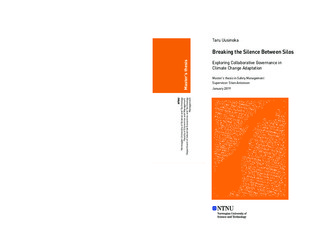Breaking the Silence Between Silos -Exploring Collaborative Governance in Climate Change Adaptation
Master thesis
Permanent lenke
http://hdl.handle.net/11250/2598709Utgivelsesdato
2019Metadata
Vis full innførselSamlinger
Sammendrag
Selv om kommunale klimastrategier la størst vekt på reduksjon av klimagassutslipp, viser det seg at klimatilpasning også ble trukket frem som en viktig faktor. Prosessen for å finne gode tilnærminger for å takle den fremvoksende risikoen knyttet til klimaendringene innebærer målkonflikter for både beslutningstakere og planleggere. Derfor er det behov til samhandling på flere organisatoriske nivåer og mellom flere sektorer.
Denne studie er en utforskende case-studie. Hensikten er å kartlegge hvilke faktorer og underliggende mekanismer som enten kan styrke eller hindre tversektorielt samarbeid i klimatilpasning. Case-studien utførsker en av de største byene i Norge som representerer et typisk case. En av de viktigste funnene er et forslag til et konkret tiltak for å forbedre selve samarbeidsprosessen: Å gi mer resursser til samordning. Funnene fremhever også at det er viktig å anarkjenne praktiske implikasjoner av manglende helhetlige strategier som ser på forholdet/grensenittet mellom utslippsreduksjon og klimatilpasning. Municipal strategies for climate change are moving beyond mitigation and beginning to highlight adaptation as well. Yet, finding adequate solutions to tackle the emerging risks posed by climate change involves conflicting objectives for decision-makers and planners. Therefore, there is a need for collective action on multiple levels and between several sectors.
The following study is an exploratory, single case study that was conducted with the intention of mapping out and describing the factors and underlying mechanisms that can either reinforce or hinder cross-sectoral collaboration in climate change adaptation. The case municipality is one of Norway’s largest cities and represents a typical case. The main findings suggest concrete measures to improve the collaborative process itself, e.g. channel more resources to the coordination efforts. The findings also highlight the importance of acknowledging the practical implications of the missing holistic interface between climate change mitigation and adaptation.
